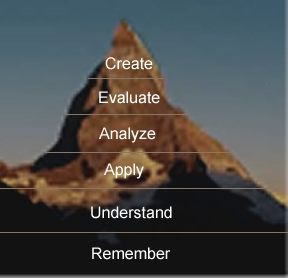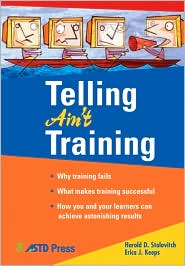Apply
 Learners effectively apply concepts, principles, methods, rules, laws, theories, and other newly learned information to novel and concrete situations in the form of measurable activity with minimal direction. In this stage, a change in behavior occurs. For example, a learner will conduct an effective negotiation session or perform conflict management via role-play. Learning outcomes require a higher level of understanding than those in the Knowledge and Understand domains.
Learners effectively apply concepts, principles, methods, rules, laws, theories, and other newly learned information to novel and concrete situations in the form of measurable activity with minimal direction. In this stage, a change in behavior occurs. For example, a learner will conduct an effective negotiation session or perform conflict management via role-play. Learning outcomes require a higher level of understanding than those in the Knowledge and Understand domains.
Performance Verbs
- Adopt
- Apply
- Avail
- Carry out
- Capitalize
- Change
- Choose
- Classify
- Collect information
- Compare and contrast
- Compute
- Conduct
- Construct (e.g. charts and graphs)
- Consume
- Deduce
- Demonstrate correct usage of a method or procedure
- Devote
- Discover
- Dramatize
- Draw conclusions
- Edit
- Employ
- Execute
- Exercise
- Exert
- Exhibit
- Experiment
- Exploit
- Handle
- Illustrate
- Implement
- Interpret
- Make
- Make use of the known
- Manage
- Manipulate
- Mobilize
- Model
- Modify
- Operate
- Organize
- Paint
- Perform
- Practice
- Predict
- Prepare
- Profit by
- Produce
- Put into action
- Put together
- Put to use
- Question
- React
- Relate
- Report
- Respond
- Role-play
- Schedule
- Share
- Shop
- Show
- Sketch
- Solve problems (real life and mathematical)
- Take up
- Translate
- Try
- Use
- Utilize
- Wield
Examples of Activities or Uses
- Apply accounting strategies to understand financial documents
- Apply ideas to new situations
- Apply laws of statistics to evaluate the reliability of a written test
- Apply learned information to a new situation
- Apply rules of correct customer service protocol while interacting with a customer in xyz situation
- Apply rule to on-the-job situation
- Apply technique learned to an authentic situation
- Apply the conflict model as learned in a role play situation
- Assemble a collection of photographs relating to the topic
- Capitalize on the idea of a social media marketing – create a social media marketing plan with various tools, promotional materials, and advertising that will promote your social media resources
- Classify product types
- Command others step-by-step to perform a new procedure
- Compare and contrast attitudes toward e-learning today and in the 1990s
- Conduct a meeting
- Conduct an experiment
- Conduct an interview
- Create a forecast based on newly learned information
- Describe a situation you have encountered that is similar to the one we just discussed
- Determine your curriculum outline for a new training program
- Dub video or TV show
- Graph information
- How does the principle of supply and demand affect your business plan
- Interview colleagues on daily activities
- Make a diagram, sculpture, illustration, mobile, collage, model, map, cartoon,
- Operate computer program to obtain a goal or objective
- Organize the types of fractures from most severe to less severe
- Participate in virtual simulation
- Play a computer game with tasks that include application of skills
- Plan a corporate event with specific company guidelines and budget
- Presentation
- Produce a newspaper, article, story, etc.
- Produce questions
- Put information in graph form
- Questioning
- Provide an instance which ___.
- How is x related to y?
- How is x an example of y?
- How would you use this information?
- How is x an example of y?
- How is x related to y?
- Why is xyz significant?
- Role-plays
- Select examples of how “private” social networking can impact one’s “public” internet footprint
- Select the most appropriate procedure for xyz situation
- Simulation activities
- Sketch a picture that relates to your ideas on effective leadership
- Solve a puzzle
- Solve problems
- based on known information
- Use knowledge from various areas to find solutions to problems
- Suggest actual uses
- Upload and share material
- Use a manual to calculate an employee’s vacation time
- Using the flow chart you created on handling customer complaints, determine which steps one should take to create customer satisfaction
- What could you say in xyz situation to overcome objections?
- Write a business proposal to your finance director
- Write a telephone conversation between a seller and a client
Filed under: Bloom's Taxonomy, E-learning, Higher Order Thinking Skills, Instructional Design, Learning, Training | Tagged: apply, Bloom's Taxonomy, Cognitive Domain, critical thinking, education, elearning, higher order thinking, instructional design, Learning, training | Leave a comment »


 Is the purpose of your training to change the behavior of your trainees and to improve workplace performance? If so, this is the book for you.
Is the purpose of your training to change the behavior of your trainees and to improve workplace performance? If so, this is the book for you. 